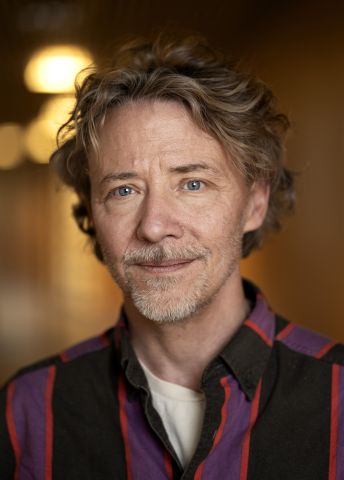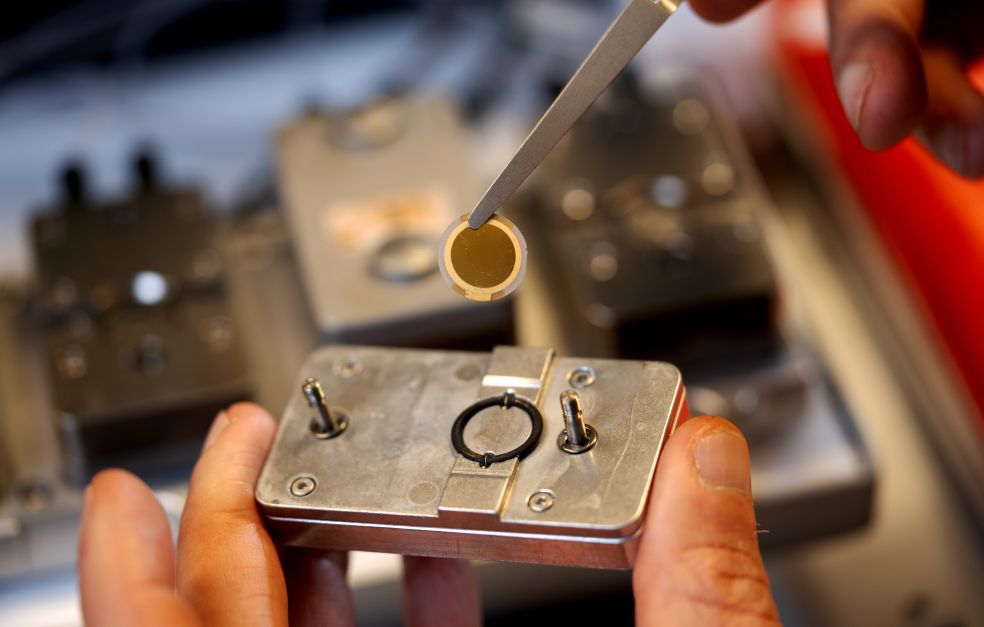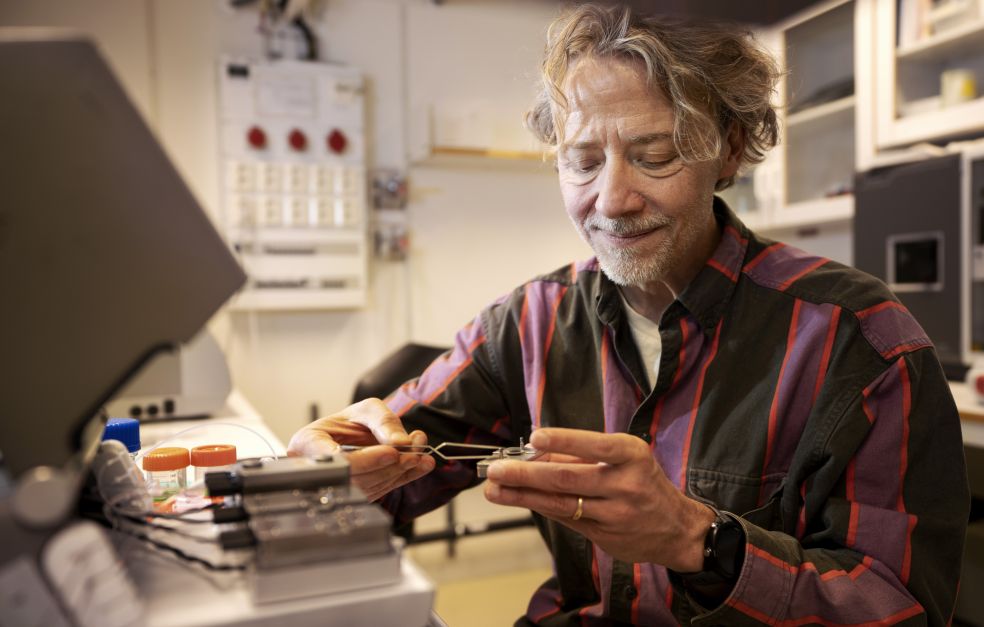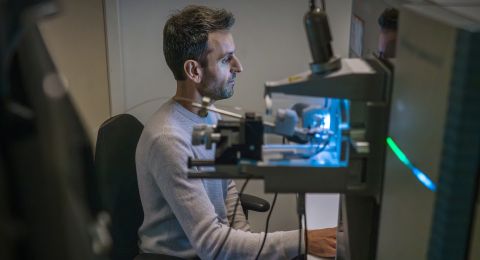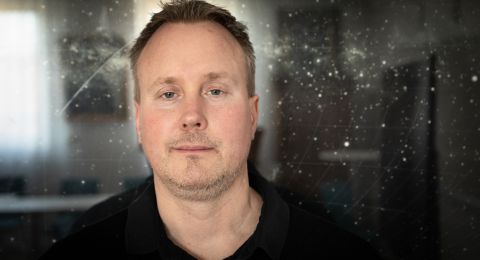Fredrik Höök is fascinated by the biological phenomena occurring in and around the thin protective sheaths of cells. He has developed groundbreaking tools to examine these processes with remarkable precision. As a Wallenberg Scholar, he is now taking the next step in advanced optical microscopy, paving the way to improving the efficacy of next generation medicines.
Fredrik Höök
Professor of Nano- and Biophysics
Wallenberg Scholar
Institution:
Chalmers University of Technology
Research field:
Development of surface-sensitive bioanalytical tools for studying interactions between nanoparticles and artificial cell membranes
Höök’s abiding research interest is the complex interplay between biological molecules. But entering this microcosm to study phenomena and particles – such as proteins, viruses or the thin outer sheaths of cells – at the nanoscale requires incredibly sensitive instruments.
“Despite belonging to the same class, many biological nanoparticles differ greatly in structure and composition. This means we cannot always view them as a homogeneous group. We must instead examine them one by one. This requires extremely sensitive measuring tools,” says Höök, a professor of nano- and biophysics at Chalmers University of Technology.
Höök himself has driven developments in the field. Over the past decades, he has devised methods and tools that have opened critical doors for biomedical research. And as research topics become increasingly advanced, the demand for ever more sensitive instruments grows.
“This can be described as a reciprocal relationship. New tools influence the answers researchers can obtain, raising new questions that drive us to develop increasingly advanced instruments,” says Höök, who describes the improvements in bioanalytical tools over the last decade as absolutely staggering.
“When I started as a researcher, millions of nanoparticles were needed to determine whether certain proteins bound to them. Nowadays we can see how proteins bind to a single nanoparticle. Huge technical strides have been made in optical microscopy, enabling us to observe processes by examining light scattering from particles. We can extract much more information from images than we used to,” he says.
How particles enter the cell
Höök is particularly interested in what happens in and around the thin protective sheath surrounding cells – the cell membrane. Cell membranes play a crucial role in many biological processes, and understanding how nanoparticles interact with and pass through cell membranes is an important question. This includes mapping how viruses enter cells, and it is important to understand how medicines can be delivered into cells via artificial nanoparticles.
These new biological drugs – such as mRNA COVID-19 vaccines – work by prompting the body to produce a protein that triggers the immune system, leading to the production of antibodies. However, the main challenge is the very low delivery efficiency: while the mRNA medicine encapsulated in nanoparticles is delivered efficiently into cells, only about one percent functions properly after delivery.
Höök’s team aims to produce knowledge vital to this issue.
“Major opportunities beckon if we can increase the delivery efficiency of these targeted drugs that reprogram cells. Our research team is trying to ascertain exactly what happens at the moment of delivery, when nanoparticles pass through the cell membrane and deliver their contents. We want to identify the mechanisms causing the low delivery efficiency. I am convinced that greater fundamental knowledge about how nanoparticles pass through cell membranes will generate entirely new ideas for improving delivery efficiency,” he says.
New tools for detailed studies
To achieve their aims, the researchers will refine highly sensitive measuring instruments for surface-sensitive optical microscopy, which the team has been working on over the past decade. The plan is to hone these tools by integrating the optical components into a chip, which simplifies handling, reduces noise interference and makes it easier to extract clear information from images.
Improvements in bioanalytical tools over the past thirty years have been absolutely staggering.
The researchers are also creating simplified structures that mimic cell membranes. They will use the microscopy tools to conduct advanced studies on how cell membranes interact with various types of nanoparticles. The level of detail is high: the tool provides simultaneous information about the size, content and structure of individual nanoparticles, and how these traits affect their function.
“We hope to achieve a fundamental understanding of the physicochemical properties responsible for effective drug delivery. This is essential in order to design artificial nanoparticles that can deliver medicines more efficiently,” he says.
The joy of sharing
Collaboration between research and society at large is important to Höök, and he has started several development companies to make the instruments and methods devised by his research group accessible to more researchers.
“It’s a fun way to disseminate research. One of the first tools we designed, for analyzing surfaces in contact with biological systems, is probably used at almost every major university in the world today,” he says.
Höök’s interest in physics was sparked by a love of mathematics, which eventually led him to a career in research. He particularly enjoys the many interdisciplinary collaborations his work involves. Over the years, his motivations have shifted.
“There was a time when I dreamed of writing a groundbreaking research article, and of course, there are articles I’m proud of. But what I’ll truly remember when I retire are all the meetings with students and doctoral candidates, inspiring interest in science and research, and all the young researchers I’ve supported, who are now carrying the torch in developing knowledge and new approaches. That is what I will cherish most,” he says.
Text Ulrika Ernström
Translation Maxwell Arding
Photo Johan Wingborg
